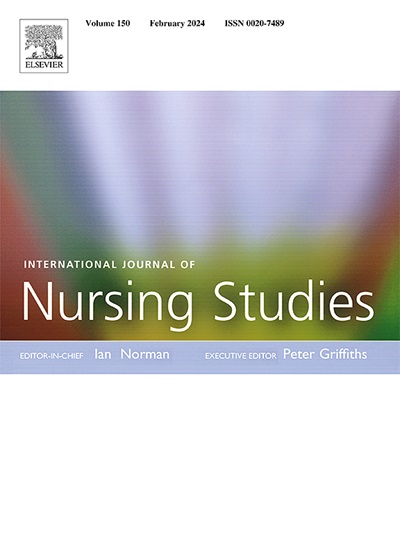术后卡通观看对幼儿出现性谵妄的影响:一项随机对照试验
IF 7.1
1区 医学
Q1 NURSING
引用次数: 0
摘要
研究表明,非药物治疗可减轻突发性谵妄的发生,副作用发生率较低,但其作用机制尚不清楚。本研究旨在探讨在麻醉后监护病房中,七氟醚麻醉苏醒后观看动画片是否能降低幼儿出现性谵妄的发生率,并检查相关的脑电图结果。方法采用单中心、随机对照试验。138名年龄2-7岁的儿童在七氟醚麻醉下接受了选择性扁桃体切除术和/或腺样体切除术,并被归类为美国麻醉医师协会身体状况I或II。患者在麻醉后护理单元随机接受标准恢复方案(对照组)或观看卡通视频(卡通组)。主要观察指标为出现性谵妄的发生率。次要结局包括小儿麻醉出现性谵妄量表、Watcha量表和面部、腿部、活动、哭泣和安慰量表得分;副作用;逗留时间;麻醉后护理单位测量额叶脑电图不对称的差异住院后行为问卷进行门诊手术评分。结果麻醉后监护病房出现谵妄的发生率卡通组(n = 69)低于对照组(n = 69) (8.7% vs. 26.1%, p = 0.012)。此外,小儿麻醉出现性谵妄量表评分为5分(中位数差值= 2,95%可信区间为1 ~ 3,p <;0.001), 15(中位数差值= 1,95%置信区间0 ~ 2,p <;0.001)和25分钟(中位数差值= 1,95%置信区间0 ~ 1,p <;0.001),以及最大得分(中位数差= 2,95%置信区间为1至3,p <;0.001),对照组高于卡通片组。80个稳定的脑电图数据集显示醒前和醒后的额叶不对称差异较低(中位数差异= - 1.208,95%可信区间为- 1.450 ~ - 0.965,p <;对照组(n = 41)与卡通组(n = 39)相比(p = 0.001),与突发性谵妄呈中度负相关(r = - 0.30, p = 0.014)。结论在七氟醚麻醉苏醒后在护理室观看卡通视频的幼儿出现突发性谵妄的发生率较低。额叶脑电图不对称的显著差异可能有助于解释这种效应。本试验已在中国临床试验注册中心注册(www.chictr.org.cn;ChiCTR2300073195。2023年7月4日注册,2023年7月5日首次招聘)。本文章由计算机程序翻译,如有差异,请以英文原文为准。
The impact of postoperative cartoon viewing on emergence delirium in young children: A randomized controlled trial
Background
Research has revealed non-pharmacological methods mitigate the occurrence of emergence delirium with a lower incidence of negative side effects, but the mechanism remains unclear. This study aimed to investigate whether postoperative cartoon viewing after awakening from sevoflurane anesthesia in the postanesthesia care unit reduces the incidence of emergence delirium in young children, and to examine relevant electroencephalography findings.
Methods
This was a single-center, randomized controlled trial. One hundred thirty-eight children aged 2–7 years who underwent elective tonsillectomy and/or adenoidectomy under sevoflurane anesthesia and who were classified as American Society of Anesthesiologists physical status I or II were included. Patients were randomized to receive a standard recovery protocol (control group) or to view a cartoon video (cartoon group) after awakening from anesthesia in the postanesthesia care unit. The primary outcome was the incidence of emergence delirium. The secondary outcomes included the Pediatric Anesthesia Emergence Delirium Scale, Watcha Scale, and the Faces, Legs, Activity, Cry, and Consolability Scale scores; side effects; length of stay; differences in frontal electroencephalographic asymmetry measured in the postanesthesia care unit; and post hospitalization behavior questionnaire for ambulatory surgery scores.
Results
The incidence of emergence delirium in the postanesthesia care unit was lower in the cartoon group (n = 69) than in the control group (n = 69) (8.7 % vs. 26.1 %, p = 0.012). In addition, the Pediatric Anesthesia Emergence Delirium Scale scores at 5 (median difference = 2, 95 % confidence interval 1 to 3, p < 0.001), 15 (median difference = 1, 95 % confidence interval 0 to 2, p < 0.001) and 25 min (median difference = 1, 95 % confidence interval 0 to 1, p < 0.001), as well as the maximal score (median difference = 2, 95 % confidence interval 1 to 3, p < 0.001), were greater in the control group than in the cartoon group. Eighty stable electroencephalography datasets revealed frontal asymmetry differences before and after awakening, which were lower (median difference = − 1.208, 95 % confidence interval − 1.450 to − 0.965, p < 0.001) in the control group (n = 41) than in the cartoon group (n = 39) and moderately negatively correlated with emergence delirium (r = − 0.30, p = 0.014).
Conclusions
Young children who viewed a cartoon video after awakening from sevoflurane anesthesia in the postanesthesia care unit demonstrated a lower incidence of emergence delirium. A considerable difference in frontal electroencephalographic asymmetry may help to explain this effect.
Registration
This trial was registered at Chinese Clinical Trial Registry (www.chictr.org.cn; ChiCTR2300073195. Registered 04/07/2023, first recruitment 05/07/2023).
求助全文
通过发布文献求助,成功后即可免费获取论文全文。
去求助
来源期刊
CiteScore
15.00
自引率
2.50%
发文量
181
审稿时长
21 days
期刊介绍:
The International Journal of Nursing Studies (IJNS) is a highly respected journal that has been publishing original peer-reviewed articles since 1963. It provides a forum for original research and scholarship about health care delivery, organisation, management, workforce, policy, and research methods relevant to nursing, midwifery, and other health related professions. The journal aims to support evidence informed policy and practice by publishing research, systematic and other scholarly reviews, critical discussion, and commentary of the highest standard. The IJNS is indexed in major databases including PubMed, Medline, Thomson Reuters - Science Citation Index, Scopus, Thomson Reuters - Social Science Citation Index, CINAHL, and the BNI (British Nursing Index).

 求助内容:
求助内容: 应助结果提醒方式:
应助结果提醒方式:


